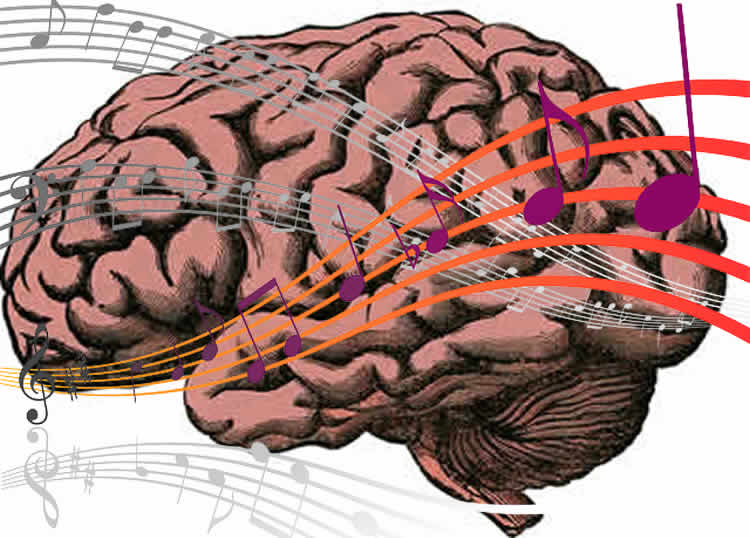Scans show brainwaves of those with disorder appear to synchronize with music.
The brains of people with epilepsy appear to react to music differently from the brains of those who do not have the disorder, a finding that could lead to new therapies to prevent seizures, according to research presented at the American Psychological Association’s 123rd Annual Convention.
“We believe that music could potentially be used as an intervention to help people with epilepsy,” said Christine Charyton, PhD, adjunct assistant professor and visiting assistant professor of neurology at The Ohio State University Wexner Medical Center, who presented the research.
Approximately 80 percent of epilepsy cases are what is known as temporal lobe epilepsy, in which the seizures appear to originate in the temporal lobe of the brain. Music is processed in the auditory cortex in this same region of the brain, which was why Charyton wanted to study the effect of music on the brains of people with epilepsy.
Charyton and her colleagues compared the musical processing abilities of the brains of people with and without epilepsy using an electroencephalogram, where electrodes are attached to the scalp to detect and record brainwave patterns. They collected data from 21 patients who were in the epilepsy monitoring unit at The Ohio State University Wexner Medical Center between September 2012 and May 2014.
The researchers recorded brainwave patterns while patients listened to 10 minutes of silence, followed by either Mozart’s Sonata for Two Pianos in D major, andante movement (K. 448), or John Coltrane’s rendition of “My Favorite Things,” a second 10-minute period of silence, the other of the two musical pieces and finally a third 10-minute period of silence. The order of the music was randomized, meaning some participants listened to Mozart first and other participants listened to Coltrane first.

The researchers found significantly higher levels of brainwave activity in participants when they were listening to music. More important, said Charyton, brainwave activity in people with epilepsy tended to synchronize more with the music, especially in the temporal lobe, than in people without epilepsy.
“We were surprised by the findings,” said Charyton. “We hypothesized that music would be processed in the brain differently than silence. We did not know if this would be the same or different for people with epilepsy.”
While she does not believe music would replace current epilepsy therapy, Charyton said this research suggests music might be a novel intervention used in conjunction with traditional treatment to help prevent seizures in people with epilepsy.
Source: Jim Sliwa – APA
Image Credit: The image is credited to NeuroscienceNews.com. We release this image into the public domain. Feel free to share or use.
Original Research: The research “Music and the Brain: Can Music Help People with Epilepsy?” will be presented at the American Psychological Association’s 123rd Annual Convention in the Metro Toronto Convention Centre, Toronto, Canada on Moday August 9 2015 at 9 am.
Abstract
Music and the Brain: Can music help people with epilepsy?
Epilepsy is the condition of having recurrent seizures and is associated with dysfuction in the frontal and temporal cortices and dysfunctional electrical activity in the brain. The purpose of this study is to determine whether or not brain electrical activity in persons with epilepsy may synchronize with music differently than persons without epilepsy. The cerebral cortex is histologically organized into long columns of cells. This arrangement amplifies the voltages generated by post synaptic potentials to the point that the can be measure through the skull, which is the basis of electroencephalogram (EEG). The voltage of a given cell column over a brief time period can be best approximated by a linear summation of cosine waves with many amplitudes, frequencies and phase angles. We can elucidate the amplitude, frequency and phase angle of each cosine wave with Fourier spectrum analysis. The electrical activity of these cortical cell columns can synchronize, which greatly increases the amplitude of EEG activity. Profound electrical synchronization between cell columns is the basis for generation of epileptic seizures. Synchronization between frequency pairs (cell columns) in EEG can be detected by bispectrum analysis. We recorded EEG in 21 consecutive patients admitted to the epilepsy monitoring unit. We recorded EEG in people with and without epilepsy at rest and while listening to music. We used bispectrum analysis in conjunction with Fourier analysis to determine the degree and distribution of synchronization. We found significantly higher levels of synchronization and spectral EEG activation when listening to music in the frontal cortex and temporal cortex, especially in persons with epilepsy. We speculate that music may be useful to enhance electrical acticity specific to the frontal and temporal cortices.
The research “Music and the Brain: Can Music Help People with Epilepsy?” will be presented at the American Psychological Association’s 123rd Annual Convention in the Metro Toronto Convention Centre, Toronto, Canada on Moday August 9 2015 at 9 am.







